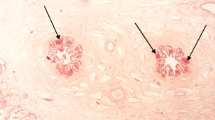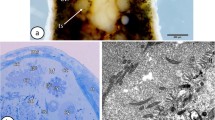Summary
This study describes the fine structure of the hamster seminal vesicle. Intact, sexually mature young and aged animals were used to obtain the results presented. The epithelium of the hamster seminal vesicle contains numerous large electron-dense structures, with a single limiting membrane, with many internal granules and, in the aged animals, myelin-like figures. Based on histochemical results presented in this study, and those of others, it is suggested that this material is a lipofuscin pigment. This substance is of special interest inasmuch as in the hamster seminal vesicle epithelium, pigment is a more sensitive indicator of circulating androgen than is, as in the case of the rat seminal vesicle, regression of cell height. It is possible that this pigment takes origin as breakdown products of mitochondria, the endoplasmic reticulum and the Golgi apparatus. The relation of “pro-pigment granules” and lysosomes is discussed. Results indicate that pigment is formed at sites of increased catabolism in response to a biological insult to the cell.
Similar content being viewed by others
References
Ashford, T., and K. Porter: Cytoplasmic components in hepatic cell lysosomes. J. cell. Biol. 12, 198–202 (1962).
Baker, J.: The histochemical recognition of lipine. Quart J. micr. Sci. 87, 441–470 (1946).
Brandes, D.: Lysosomes in prostatic epithelium of older and castrate rats. Electron Microscopy 2, VV-14 (1962).
—, W. D. Belt, and G. Bourne: Preliminary remarks concerning fine structure of the epithelium of the coagulating gland. Exp. Cell. Res. 16, 683–685 (1959).
—, G. Bourne, and A. Portela: The fine structure of the epithelial cells of the mouse prostate gland. I. Coagulating gland epithelium. J. biophys. biochem. Cytol. 7, 505–510 (1959).
—: The fine structure of the epithelial cells of the mouse prostate. II. Ventral lobe epithelium. J. biophys. biochem. Cytol. 7, 511–520 (1960).
Cavazos, L. F., and R. M. Melampy: Cytological effects of testosterone propionate on epithelium of rat seminal vesicles. Endocrinology 54, 640–648 (1954).
Deane, H., and K. Porter: A comparative study of cytoplasmic basophilia and the population density of ribosome in the secretory cells of mouse seminal vesicles. Z. Zellforsch. 52, 697–711 (1960).
- Electron microscopic observation on the mouse seminal vesicle. Nat. Cancer Inst. Monogr. No 12, 63–83 (1963).
Deduve, C.: Lysosomes, a new group of cytoplasmic particles. In: Subcellular particles, T. Hayashi ed., pp. 128–159. New York: Ronald Press 1959.
El Gohary, M., L. F. Cavazos, and J. P. Manning: Effects of testosterone on histochemical reactions of epithelium of hamster ductus epididymidis and seminal vesicle. Anat. Rec. 144, 229–237 (1962).
Feagans, W. M., L. F. Cavazos, and A. T. Ewald: A morphological and histochemical study of estrogen-induced lesions in the hamster male reproductive tract. Amer. J. Anat. 108, 31–45 (1961).
Fugita, M.: The fine structure of the epithelial cell of the mouse seminal vesicle studied with the electron microscope. (In Japanese.) J. Kurume med. Ass. 22, 536–558 (1959). Cit. by Deane and Porter 1960.
Gomori, G.: An improved histochemical technic for acid phosphatase. Stain Technol. 25, 81–85 (1950).
Moore, C., W. Hughes, and T. Gallagher: Rat seminal-vesicle cytology as a testis-hormone indicator and the prevention of castration changes by testis-extract injection. Amer. J. Anat. 45, 109–135 (1930).
Novikoff, A.: Lysosomes and related particles. In: The cell. J. Brachet and A. E. Mirsky, eds., vol. 2, p. 423–488. New York: Academic Press. Inc. 1961.
Ortiz, E.: The effects of castration on the reproductive system of the golden hamster. Anat. Rec. 117, 65–92 (1953).
Palade, G. E.: A study of fixation for electron microscopy. J. exp. Med. 95, 285–296 (1952).
Pease, D.: Buffered formaldehyde as a killing agent and primary fixative for electron microscopy. Anat. Rec. 142, 342 (1962).
Rhodin, J.: An atlas of ultrastructure, 222 pp. Philadelphia and London: W. B. Saunders Co. 1963.
Sabatini, D., K. Bensch, and R. Barrnett: Cytochemistry and electron microscopy. The preservation of cellular ultrastructure and enzymatic activity by aldehyde fixation. J. Cell Res. 17, 19–58 (1963).
Szirmai, J., and P. C. van der Linde: The fine structure of the seminal vesicles in normal and castrated rats. Electron Microscopy 2, TT-9 (1962).
Author information
Authors and Affiliations
Additional information
Supported by U.S.P.H.S. grant RG 6583 from the National Institutes of Health, National Institute of General Medical Sciences.
Rights and permissions
About this article
Cite this article
Cavazos, L.F., Belt, W.D., Sheridan, M.N. et al. The fine structure of the hamster seminal vesicle with special reference to pigment formation. Zeitschrift für Zellforschung 63, 179–193 (1964). https://doi.org/10.1007/BF00339446
Received:
Issue Date:
DOI: https://doi.org/10.1007/BF00339446




